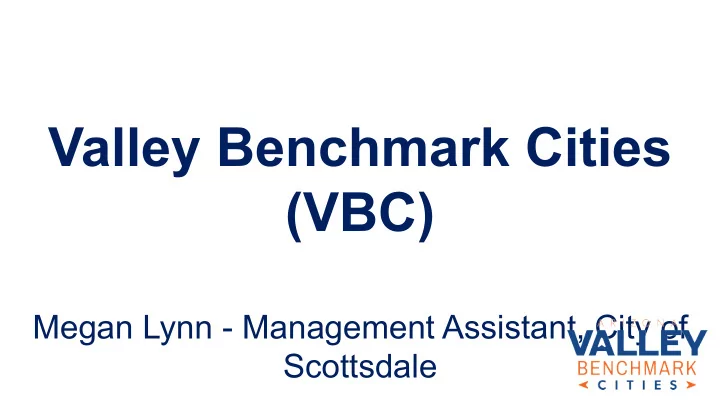

Valley Benchmark Cities (VBC) Megan Lynn - Management Assistant, City of Scottsdale
• Why benchmark? • History • Process • Trend reports and performance measures • Examples of use • Lessons learned and advice • Key takeaways
Why Benchmark?
Context is needed
Benchmarking • The art of evaluating by comparison with a standard for learning and improvement
Comparisons can be challenging
Monthly residential utility bill
Without comparisons • You don’t know what you don’t know • Have no explanation for variation • Reasons why you got the results • Reliability / validity of data
Ways to gain comparative insight • ICMA and professional associations • Budget Comparisons • Media sources • County/State/Federal Data Sources
How networks can help • Discussions to gain understanding • Identify best practices and improve the services we provide • Track progress and trends • Improve accuracy
“Evidence suggests that improved performance occurs at a much greater rate when performance measures are compared.” Smith and Cheng, 2004
History
Phoenix is almost 7 times larger than Scottsdale!
Valley Benchmark Cities
Early comparative efforts • Sales Taxes • Property Taxes • Utility Bills • Permit and Development Fees • Land Use Impacts • Salaries and Benefits
Stay resident-focused! 1. Keep crime low 2. Response time if my home catches fire 3. Make sure my garbage gets picked up 4. Make sure my water is clean 5. Make sure the streets are fixed
What have we measured? Sales/Property Taxes • Permit/ Development Fees • Demographics • Public Safety • Libraries • Streets and Utilities • Administration/ Finance • FTE Comparisons • Police/Fire Response Times • Parks/Recreation Measures • Economic Development
Why did we do this? • We didn’t have concrete answers to the question from elected officials: How does this compare to … ? • Couldn’t get the information we needed from existing sources • City manager committed to council to join a performance consortium
Do your background work Identify similar size and scope jurisdictions within your region/state NOTE: National comparisons are more complex due to differences in climate, geography, demand levels, political environment, funding differences, etc.
Build support for the idea • Talk to staff who would be involved (assistant city managers, assistant tos, budget directors, ICMA primary coordinator) AND • Talk to key managers directly (ICMA Conference, state association conferences, regional meetings, etc.) • “Do elected officials ever ask, what do others do?”
Key steps in forming a network • Identify and invite key leaders • Identify potential partners • Build rapport by learning from others • Dialogue about efforts already underway • Begin collecting and sharing information
Agree on a common purpose Identify common financial and performance information that we agree to share and discuss with each other for the purpose of better understanding the similarities and differences between our operations, with the ultimate aim of improving local government performance.
Process
Current process • ASU fellow serves as project lead • Meet monthly (September–June) • Create a workplan • Data collection and review • Assign deep dive collections • City Managers have final report approval
Trend Reports and Performance Measures
In March 2019, we published our FY2017/18 Trend Report, our fifth trend report to date
Examples of Use
“VBC provides an effective and accurate way for our departments to see how their performance stacks up against their peers. For example, the FY15-16 report showed that Gilbert’s Fire response times were below average. We were then in the process of adding an additional fire station, so when council expressed concern over the low performance, we were able to explain that measures were already being taken to improve our performance.” – VBC Member
“Aside from the formal benchmarking report and analysis, a great degree of value is derived from the informal information sharing that takes place. Because we have a built-in network of peer communities, we can effortlessly poll for research on various policies and practices that may be of interest to our respective organizations.” – VBC Member
Lessons Learned and Advice
• Make sure it’s City Manager supported • Get support from local college/national benchmarking group • Trust is key and not everything needs to be published • Know what you are trying to measure • Use your subject-matter experts • Pace yourself – start with several key measures and build on that over time
Key Takeaways
• Comparisons help us understand how well we are doing, and provide context to improve services • It helps to have jurisdictional commitment, mutual trust, willingness to share data and resources and a neutral facilitator • Patience and
Valley Benchmark Cities (VBC) For full report: transformgov.org/valley- benchmark-cities Megan Lynn - Management Assistant, City of Scottsdale
Recommend
More recommend